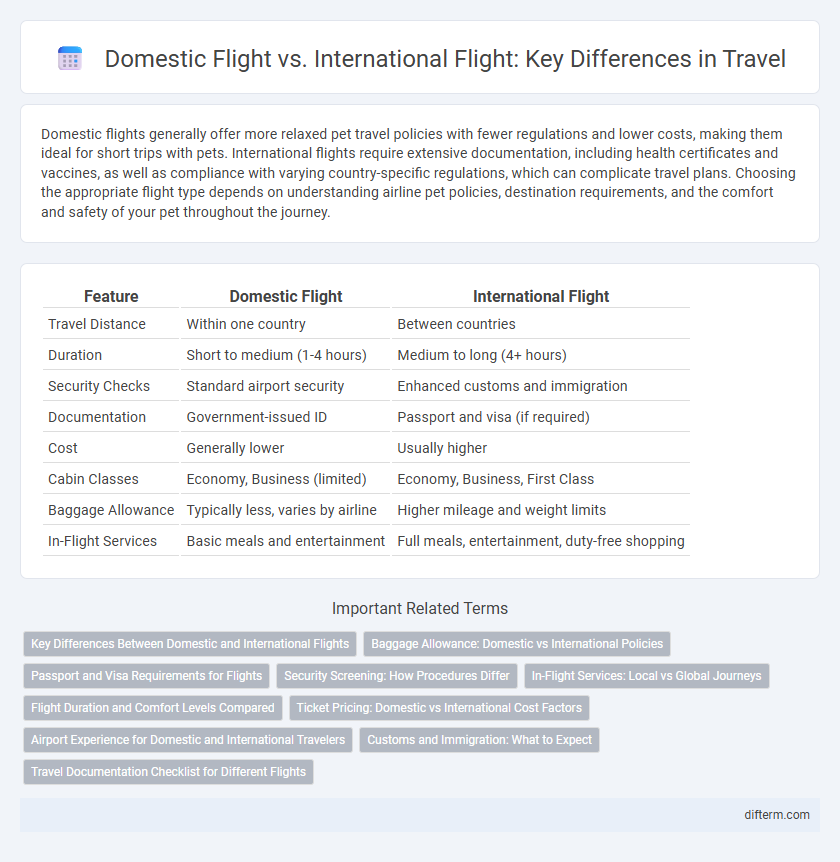Domestic flights generally offer more relaxed pet travel policies with fewer regulations and lower costs, making them ideal for short trips with pets. International flights require extensive documentation, including health certificates and vaccines, as well as compliance with varying country-specific regulations, which can complicate travel plans. Choosing the appropriate flight type depends on understanding airline pet policies, destination requirements, and the comfort and safety of your pet throughout the journey.
Table of Comparison
| Feature | Domestic Flight | International Flight |
|---|---|---|
| Travel Distance | Within one country | Between countries |
| Duration | Short to medium (1-4 hours) | Medium to long (4+ hours) |
| Security Checks | Standard airport security | Enhanced customs and immigration |
| Documentation | Government-issued ID | Passport and visa (if required) |
| Cost | Generally lower | Usually higher |
| Cabin Classes | Economy, Business (limited) | Economy, Business, First Class |
| Baggage Allowance | Typically less, varies by airline | Higher mileage and weight limits |
| In-Flight Services | Basic meals and entertainment | Full meals, entertainment, duty-free shopping |
Key Differences Between Domestic and International Flights
Domestic flights typically involve shorter travel distances and less stringent security procedures compared to international flights, which require passport control, customs checks, and often longer check-in times. Ticket prices for international flights are generally higher due to factors like fuel surcharges, taxes, and more complex logistics. Airlines operating international routes also offer extended in-flight services such as meals and entertainment, while domestic flights emphasize quick turnaround and efficiency.
Baggage Allowance: Domestic vs International Policies
Domestic flights typically offer more flexible baggage allowances with lower fees for checked and carry-on bags, often allowing one free carry-on and one personal item. International flights enforce stricter baggage policies with weight limits ranging from 20kg to 30kg for checked bags and higher fees for excess weight, influenced by airline and destination regulations. Understanding these differences helps travelers optimize packing strategies and avoid unexpected charges during both domestic and international journeys.
Passport and Visa Requirements for Flights
Domestic flights typically only require a government-issued photo ID, such as a driver's license, while international flights mandate a valid passport for entry and exit verification. Visa requirements vary widely depending on the destination country and traveler nationality, with some countries requiring pre-approved visas or electronic travel authorizations before boarding international flights. Travelers must verify specific passport validity rules and visa policies to ensure smooth customs and immigration processing when booking international flights.
Security Screening: How Procedures Differ
Security screening for domestic flights typically involves standard TSA procedures such as metal detectors and X-ray scans with fewer documentation checks. International flights require more rigorous protocols, including passport verification, customs inspections, and additional screening for liquids and electronics. These differences ensure compliance with global aviation security standards while addressing specific risks associated with cross-border travel.
In-Flight Services: Local vs Global Journeys
In-flight services on domestic flights typically emphasize efficiency and comfort tailored to shorter durations, offering limited meal options and basic entertainment. International flights provide extensive amenities including multi-course meals, diverse entertainment systems, and multilingual cabin crew, addressing varied cultural preferences. Airlines adapt these services to enhance passenger experience based on flight length and destination complexity.
Flight Duration and Comfort Levels Compared
Domestic flights typically offer shorter flight durations, ranging from 1 to 4 hours, which enhances passenger comfort by reducing travel fatigue. International flights often exceed 6 hours, requiring amenities like reclining seats, in-flight entertainment, and meal services to maintain comfort on longer journeys. Airlines prioritize cabin pressure control and noise reduction in international flights to improve overall passenger experience during extended travel times.
Ticket Pricing: Domestic vs International Cost Factors
Domestic flight ticket pricing is often influenced by factors such as shorter distances, higher flight frequencies, and lower airport fees, resulting in generally lower costs compared to international flights. International flights incorporate expenses like customs fees, higher fuel consumption for longer routes, diverse airline alliances, and varying taxation policies, all contributing to increased ticket prices. Airlines also adjust pricing based on demand elasticity, seasonality, and airport infrastructure differences between domestic and international destinations.
Airport Experience for Domestic and International Travelers
Domestic flights often provide a quicker airport experience with streamlined security checks and shorter wait times, ideal for travelers prioritizing efficiency. International flights involve more comprehensive procedures, including passport control, customs, and longer security lines, reflecting heightened security and regulatory requirements. Airports serving international routes typically offer enhanced amenities such as duty-free shopping and currency exchange to accommodate diverse traveler needs.
Customs and Immigration: What to Expect
Domestic flights typically require only standard security checks without the need for customs or immigration procedures, allowing passengers to move quickly through airport checkpoints. International flights involve thorough customs and immigration processes, including passport control, visa verification, and declaration of goods, which can significantly increase wait times. Travelers should prepare necessary documents in advance and anticipate longer processing times when flying internationally to ensure a smooth transition.
Travel Documentation Checklist for Different Flights
Domestic flights typically require a government-issued photo ID such as a driver's license or national ID card, while international flights mandate a valid passport and often a visa for the destination country. Travelers should also check specific airline policies and entry requirements like health certificates or COVID-19 test results to avoid delays. Ensuring all travel documents are up-to-date and readily accessible streamlines the boarding process and complies with immigration regulations.
domestic flight vs international flight Infographic

 difterm.com
difterm.com